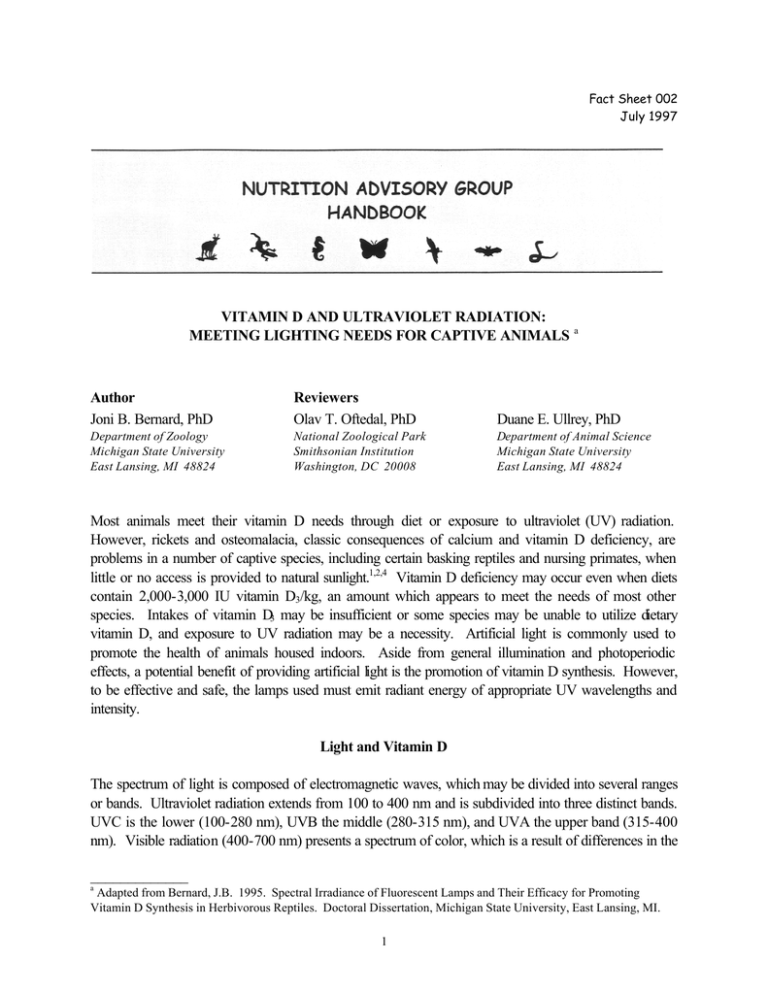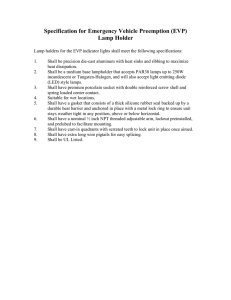vitamin d and ultraviolet radiation: meeting lighting
advertisement

Fact Sheet 002 July 1997 VITAMIN D AND ULTRAVIOLET RADIATION: MEETING LIGHTING NEEDS FOR CAPTIVE ANIMALS a Author Joni B. Bernard, PhD Reviewers Olav T. Oftedal, PhD Duane E. Ullrey, PhD Department of Zoology Michigan State University East Lansing, MI 48824 National Zoological Park Smithsonian Institution Washington, DC 20008 Department of Animal Science Michigan State University East Lansing, MI 48824 Most animals meet their vitamin D needs through diet or exposure to ultraviolet (UV) radiation. However, rickets and osteomalacia, classic consequences of calcium and vitamin D deficiency, are problems in a number of captive species, including certain basking reptiles and nursing primates, when little or no access is provided to natural sunlight.1,2,4 Vitamin D deficiency may occur even when diets contain 2,000-3,000 IU vitamin D3/kg, an amount which appears to meet the needs of most other species. Intakes of vitamin D3 may be insufficient or some species may be unable to utilize dietary vitamin D, and exposure to UV radiation may be a necessity. Artificial light is commonly used to promote the health of animals housed indoors. Aside from general illumination and photoperiodic effects, a potential benefit of providing artificial light is the promotion of vitamin D synthesis. However, to be effective and safe, the lamps used must emit radiant energy of appropriate UV wavelengths and intensity. Light and Vitamin D The spectrum of light is composed of electromagnetic waves, which may be divided into several ranges or bands. Ultraviolet radiation extends from 100 to 400 nm and is subdivided into three distinct bands. UVC is the lower (100-280 nm), UVB the middle (280-315 nm), and UVA the upper band (315-400 nm). Visible radiation (400-700 nm) presents a spectrum of color, which is a result of differences in the _____________ a Adapted from Bernard, J.B. 1995. Spectral Irradiance of Fluorescent Lamps and Their Efficacy for Promoting Vitamin D Synthesis in Herbivorous Reptiles. Doctoral Dissertation, Michigan State University, East Lansing, MI. 1 relative energies and discernible colors of the light emitted. Above visible radiation is infrared (7003,200 nm) which contributes radiant heat. Natural sunlight which reaches the earth's surface includes near infrared, visible light, UVA and some UVB, whereas wavelengths below 285 nm and above 2,500 nm are normally filtered by the earth's atmosphere. Vitamin D3 is formed in the skin, of most species studied, with appropriate UV exposure. The conversion of 7-dehydrocholesterol (vitamin D precursor in the skin) to previtamin D3 generally occurs upon irradiative exposure between 285-315 nm. Previtamin D3 is then thermally converted to vitamin D3. Thus, the critical range of wavelengths for vitamin D3 biosynthesis falls within the UVB range, and more specifically, the most effective energies are from 290-300 nm. Other wavelengths may, however, have some regulatory effects on vitamin D production. Characteristics of Light Sources Many lamps are marketed specifically for animal use, and even larger numbers of lamp types are utilized in zoos. Incandescent lamps emit light from filaments that glow as they are heated by their resistance to transmission of electricity. Light emitted from commercially available incandescent lamps tends to be primarily visible and infrared radiation. Incandescent sunlamps that emit UV light are no longer commercially available in the United States due to serious health risks. Fluorescent lamps emit light from fluorescing powders, or phosphors, that coat the inner walls and that are activated by energy generated by a mercury arc. The spectrum of light emitted is a function of the nature of the phosphors and the light-transmitting characteristics of the envelope that surrounds them. Selection of a fluorescent lamp to promote the cutaneous production of vitamin D3 and to illuminate animal exhibits properly requires some knowledge of the lamp's visual qualities and its energy output at various wavelengths. Color balance is established by the relative energies of bands of light in the visible range. Fluorescent lamps designated warm white have a reddish tone, cool white lamps have a blue hue, and daylight lamps have more of a white appearance. Blacklights provide a high intensity of UVA, usually with little visible light or UVB. The quality of light emitted by a lamp may be described by the correlated color temperature (CCT), which is a comparison of the color of light emitted from a lamp to that emitted by a reference standard, and is expressed in degrees Kelvin (K). CCT is not, however, a measurement of actual temperature. As color temperature increases, color shifts in a continuum through the color spectrum from red to blue-white. The sun is considered a reference standard with a CCT generally between 5,000 and 7,000° K. The quality of light emitted by a lamp may also be described by the color rendering index (CRI). The sun is given a CRI of 100 and is the basis against which all lamps are measured. The CRI of fluorescent lamps labeled "full spectrum" can be as high as 94. While such a lamp may provide appealing illumination of animal exhibits, the label "full spectrum" is often misleading. The spectral balance of most of these lamps does not include sufficient energy in the UVB range to promote vitamin D synthesis. Lamps The spectral irradiance (250-700 nm) of 15 commonly used, commercially available fluorescent lamps and 5 experimental fluorescent lamps has been examined. While a few of the commercially available 2 lamps may be effective in promoting vitamin D3 biosynthesis if an animal is very close for extended periods of time, there are currently no commercially available “full spectrum” lamps which have been demonstrated to be safe and effective in providing sufficient UV energy for vitamin D synthesis in a large exhibit. The experimental lamps, containing varying proportions of the Sylvania 2096 UVB-emitting phosphor (Sylvania Lighting, Danvers, MA), were very active in promoting vitamin D3 biosynthesis. Additionally, the most recent version of the experimental lamp provided appropriate color balance (CCT 5,600° K; CRI 91) for display purposes. This lamp was shown not only to be effective at converting 7-dehydrocholesterol to vitamin D3, in vitro, at distances as great as 213 cm (approximately 7 ft), but has also been demonstrated with green iguanas (Iguana iguana) to be effective and safe, in vivo, at distances as close as 61 cm (approximately 2 ft). The UV output of this lamp was designed to be within the limits of safety for 8 hr of exposure established for humans by the National Institute for Occupational Safety and Health (NIOSH).3 Unfortunately, this lamp is not currently commercially available. Recommendations When vitamin D requirements cannot be met by diet, direct solar exposure is the most effective method of promoting biosynthesis of vitamin D. An alternative, if environmental and physical circumstances do not permit direct exposure, is solar exposure through windows or skylights, made of material such as Solacryl UVT® (Polycast Technology Corporation, Stamford, CT) that transmits near infrared, visible, UVA, and UVB radiation. For those situations where direct or indirect solar exposure is not possible, artificial lighting may be necessary. Most “full spectrum” lamps offer excellent general illumination, but provide very little UVB. However, the GE Chroma 50 (General Electric Lighting, Cleveland, OH) offers acceptable general illumination and emitted sufficient UVB to sustain serum vitamin D metabolites in healthy green iguanas when they were within 46 cm (18 in) and irradiated for 12 hr/day. The Sylvania Design 50 has a 6-fold higher energy output in the critical wavelength range (290-300 nm) than the GE Chroma 50 and should be more effective in supporting vitamin D synthesis, but has not been tested on animals. Blacklights, by definition, are UVA emitters and emit little, if any, UVB. However, there is a blacklight which has been identified that emits more UVB than other commercially available lamps studied, the Sylvania 350 Blacklight. Reasonable amounts of UVB and acceptable general illumination may be provided by use of two-lamp fixtures containing the Sylvania 350 Blacklight in combination with a daylight or “full spectrum” lamp. While this combination has not been tested on animals, it is likely to be more efficacious than other artificial lighting options. To assure sufficient vitamin D synthesis, it may be necessary to encourage animals to bask near the lamp by strategic placement of a supplemental heat source. Additionally, a shaded area should be provided to which animals may retreat from extended artificial light exposure, just as they might escape prolonged solar exposure in their natural habitat. 3 Literature Cited 1 Allen, M.E., O.T. Oftedal and R.L. Horst. 1996. Remarkable differences in the response to dietary vitamin D among species of reptiles and primates: Is ultraviolet B light essential? Pp. 13-30 in Holick, M.F. and E.G. Jung (eds). Biologic Effects of Light 1995. Walter de Gruyter, Berlin. 2 Morrisey, J.K., T. Reichard, M. Lloyd and J. Bernard. 1995. Vitamin D-deficiency rickets in three colobus monkeys (Colobus guereza kikuyuensis) at the Toledo Zoo. J. Zoo Wildl. Med. 26:564-568. 3 National Institute for Occupational Safety and Health. 1972. Criteria for a Recommended Standard. Occupational Exposure to Ultraviolet Radiation. U.S. Department of Health, Education and Welfare, Washington, D.C. 4 Vickers, J.H. 1968. Osteomalacia and rickets in monkeys. Pp. 392-393 in Kirk, R.W. (ed). Current Veterinary Therapy III. W.B. Saunders, Philadelphia, PA. 4



